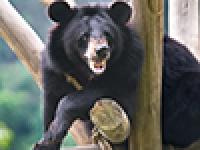Misery ends for sickest of dogs
18 January 2009, 22:20PM
On this latest trip to Qimeng Rescue Centre I remembered to bring tissues. “Little Eddie” has had two reprieves now as her health goes up and down – and I’d convinced myself that I would be holding her frail little body for the last time. This is a photo of her that Rainbow Zhu, our Education Manager, took as she arrived on the truck:
The task of selecting dogs for humane euthanasia is grim and the responsibility is shared among all members of the team in order to cover everything from veterinary, welfare and the potential of finding new homes – in order to give each and every dog their best chance.
Starting from the rescue on New Year’s Eve, we began to check, grade for body condition and general health, and vaccinate against disease if we thought they had a chance. Others with obvious disease were euthanised in our effort to protect the other dogs.
Sadly, however, we couldn’t predict which of the dogs were actually incubating disease at the same time and could only pray that the vaccinations gave them some help in fighting sickness, which had been spreading across that group as they waited to be trucked to slaughter in Guangzhou.
Today, we are seeing many of those same dogs we tried to protect now becoming sick – showing the reality of disease which slowly invades their bodies until the clinical signs emerge. Eyes that were bright and expectant are now sunken and dull, and mucus drips from noses that were clean and healthy before.
Today, we have to face facts – most of these dogs never stood a chance. The majority had been raised as meat dogs – no care, no proper diet and no protection given against disease. For many, our efforts to help them were futile. Crammed together in holding pens and then on the truck, the diseases they had been carrying quickly spread and by the time we offloaded the cages – the fate, for many, was sealed.
It has been truly horrible – devastating – for us all to see animals we had grown so fond of, now so sick. Cries of “oh no” and gulps of sadness echoed around as we pointed at dogs who had finally succumbed to the ravages of disease.
Giving them sedatives to send them gently under, before administering the euthanasia drug, lay heavy on our hearts. As the needles slipped into the veins there were soft words of “go peacefully little guy”, “so sorry”, and “now you can run with the rabbits”. We cried – unashamedly – for members of a species we adore, but couldn't help this time.
Equally with the aggressive dogs – animals we know just might stand a chance if they could only be adopted by kind and patient people willing to spend long hours regaining trust which has long since been lost. But these are animals we know nothing about.
These are animals violently attacking the other dogs, causing bite wounds and injury, and responsible for such misery in the groups. These are dogs that are also a potential threat to people when we just can’t be sure whether rabies is present at this time.
Today we have 66 dogs left – but again we cannot be complacent; nor can we guarantee their future. Over the next few weeks, much will dictate whether they succumb to disease. Some will have stronger immune systems than others and we can only help by re-vaccinating, advising an appropriate diet, and prescribing antibiotics to those that need them.
And still as they become stronger, more confident, their characters come shining through – slowly, but positively, and making us smile. Potato Head, a strange-shaped boy with a head too large for his body charges around the enclosure with his best friend, Jeeves, truly enjoying their days in the cold winter sun.
Wooster, the chocolate lab, is also bright-eyed and full of beans and hope runs eternal that these robust young dogs have a fighting chance. A little dalmatian bitch (a breeding machine in her past life from looking at her worn out body) was a dog we couldn’t get near before; she snapped at us nervously just to make the point. She is a different dog today.
Sitting by our vet, Leanne, you could see she was ready to start trusting this strange species, which had only hurt her before and, within a few minutes, she was nudging Leanne's arm and asking for a tickle.
As for Little Eddie, it is hard to predict. She has been on “the list” each visit and is termed as “borderline”. For about 30 minutes, while some of our staff were taking a quick break, I sat on the ground with her on my lap. She has no discharge, no obvious clinical signs, except that she is often “flat” in demeanour, skeletally thin and not particularly bothered with food.
At other times she is bright – trotting round the enclosure, curiously sniffing the other dogs and always happy to come over for a cuddle when we call. And this time she wolfed down three large sausages faster than the speed of sound.
With fewer dogs in the enclosures, Leanne made the decision that she should be moved into one of the small runs, could continue with her antibiotics and we would re-assess again next week. As she lay sleeping, I knew there was nothing else we could do for her now – and her life would end or continue as fate plays a hand.
Recent Posts
June 05, 2024
A soothing balm for humans – a life-saving change for bears.
March 30, 2024
February 08, 2024






